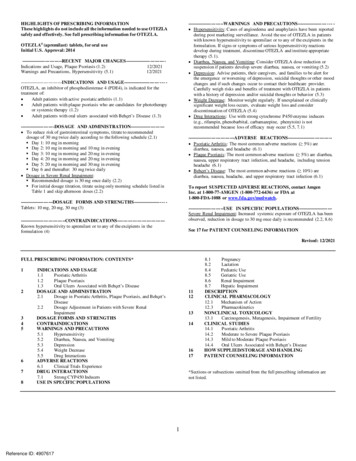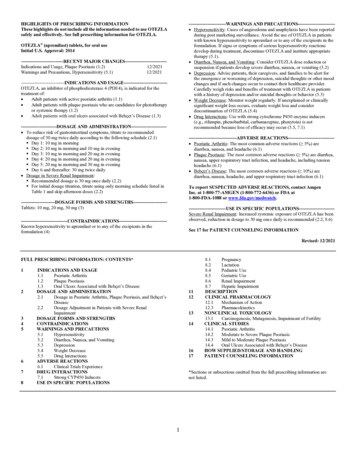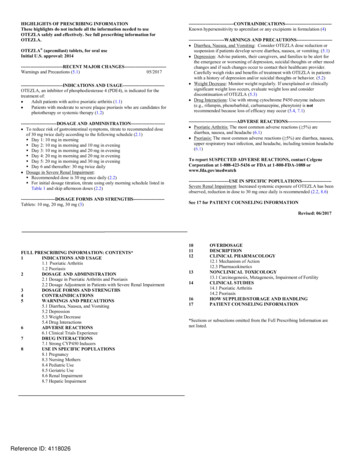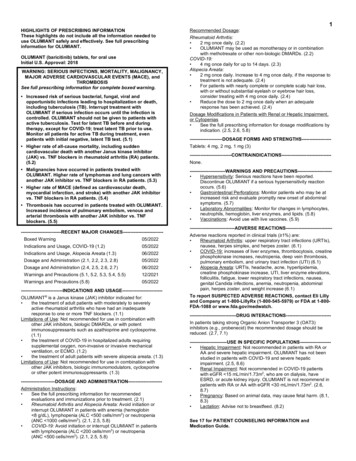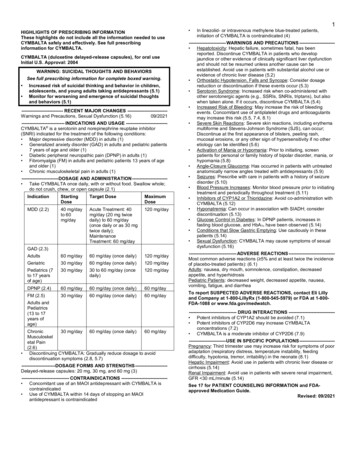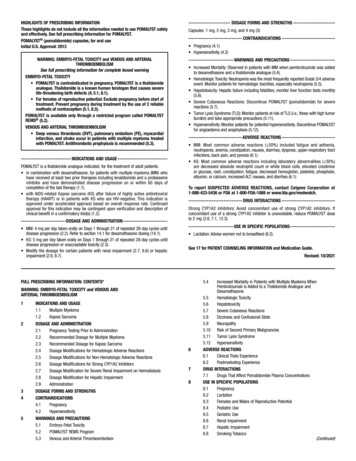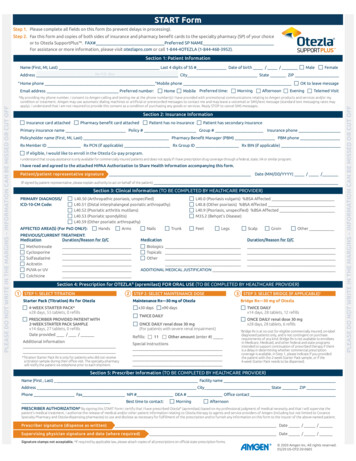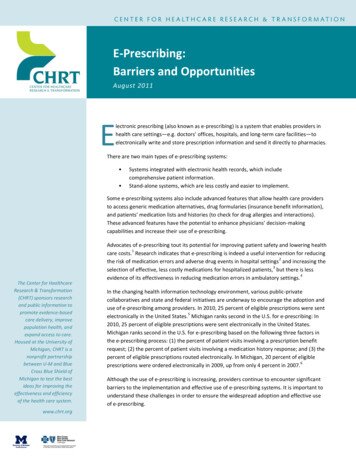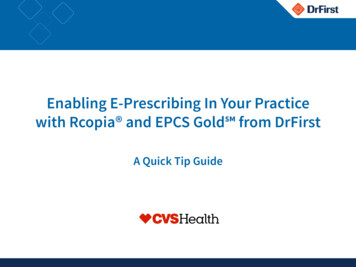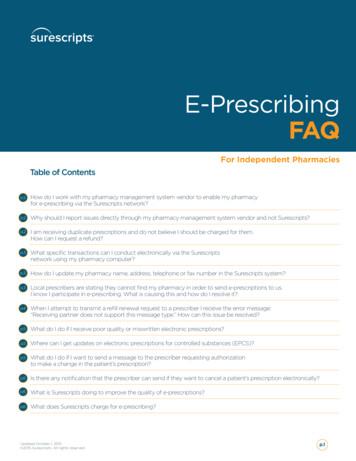
Transcription
HIGHLIGHTS OF PRESCRIBING INFORMATIONThese highlights do not include all the information needed to useOTEZLA safely and effectively. See full prescribing information forOTEZLA.OTEZLA (apremilast) tablets, for oral useInitial US Approval: 2014---------------------------RECENT MAJOR CHANGES-------------------------- Indication and Usage (1.2)09/2014Dosage and Administration (2.1)09/2014Warnings and Precautions (5.1, 5.2 )09/2014---------------------------INDICATIONS AND USAGE--------------------------OTEZLA, an inhibitor of phosphodiesterase 4 (PDE4), is indicated for thetreatment of :xAdult patients with active psoriatic arthritis (1.1)xPatients with moderate to severe plaque psoriasis who arecandidates for phototherapy or systemic therapy (1.2)-----------------------DOSAGE AND ADMINISTRATION--------------------- x To reduce risk of gastrointestinal symptoms, titrate to recommended doseof 30 mg twice daily according to the following schedule (2.1) Day 1: 10 mg in morning Day 2: 10 mg in morning and 10 mg in evening Day 3: 10 mg in morning and 20 mg in evening Day 4: 20 mg in morning and 20 mg in evening Day 5: 20 mg in morning and 30 mg in evening Day 6 and thereafter: 30 mg twice dailyx Dosage in Severe Renal Impairment: Recommended dose is 30 mg once daily (2.2) For initial dosage titration, titrate using only morning schedule listed inTable 1 and skip afternoon doses S------------------------------ Known hypersensitivity to apremilast or any excipients in formulation (4)-----------------------WARNINGS AND PRECAUTIONS---------------------- x Depression: Advise patients, their caregivers, and families to be alert forthe emergence or worsening of depression, suicidal thoughts or other moodchanges and if such changes occur to contact their healthcare provider.Carefully weigh risks and benefits of treatment with OTEZLA in patientswith a history of depression and/or suicidal thoughts or behavior. (5.1)x Weight Decrease: Monitor weight regularly. If unexplained or clinicallysignificant weight loss occurs, evaluate weight loss and considerdiscontinuation of OTEZLA (5.2)x Drug Interactions: Use with strong cytochrome P450 enzyme inducers(e.g., rifampin, phenobarbital, carbamazepine, phenytoin) is notrecommended because loss of efficacy may occur (5.3, 7.1)-------------------------------ADVERSE REACTIONS---------------------------x Psoriatic Arthritis: The most common adverse reactions ( 5%) arediarrhea, nausea, and headache (6.1)x Psoriasis: The most common adverse reactions ( 5%) are diarrhea, nausea,upper respiratory tract infection, and headache, including tension headache(6.1)To report SUSPECTED ADVERSE REACTIONS, contact CelgeneCorporation at 1-888-423-5436 or FDA at 1-800-FDA-1088 E IN SPECIFIC POPULATIONS------------------ Severe Renal Impairment: Increased systemic exposure of OTEZLA has beenobserved, reduction in dose to 30 mg once daily is recommended (2.2, 8.6)See 17 for PATIENT COUNSELING INFORMATIONRevised: 09/2014----------------------DOSAGE FORMS AND STRENGTHS------------------- Tablets: 10 mg, 20 mg, 30 mg (3)FULL PRESCRIBING INFORMATION: CONTENTS*1INDICATIONS AND USAGE1.1 Psoriatic Arthritis1.2 Psoriasis2DOSAGE AND ADMINISTRATION2.1 Dosage in Psoriatic Arthritis and Psoriasis2.2 Dosage Adjustment in Patients With Severe Renal Impairment3DOSAGE FORMS AND STRENGTHS4CONTRAINDICATIONS5WARNINGS AND PRECAUTIONS5.1 Depression5.2 Weight Decrease5.3 Drug Interactions6ADVERSE REACTIONS6.1 Clinical Trials Experience7DRUG INTERACTIONS7.1 Strong CYP450 Inducers8USE IN SPECIFIC POPULATIONS8.1. Pregnancy8.3. Nursing Mothers8.4. Pediatric Use8.5. Geriatric Use8.6. Renal Impairment8.7. Hepatic ImpairmentReference ID: 3632826101112 13141617OVERDOSAGEDESCRIPTIONCLINICAL PHARMACOLOGY12.1. Mechanism of Action12.3. PharmacokineticsNONCLINICAL TOXICOLOGY13.1. Carcinogenesis, Mutagenesis, Impairment of FertilityCLINICAL STUDIES14.1 Psoriatic Arthritis14.2 PsoriasisHOW SUPPLIED/STORAGE AND HANDLINGPATIENT COUNSELING INFORMATION*Sections or subsections omitted from the Full Prescribing Information arenot listed.
FULL PRESCRIBING INFORMATION1INDICATIONS AND USAGE1.1Psoriatic ArthritisOTEZLA is indicated for the treatment of adult patients with active psoriatic arthritis.1.2PsoriasisOTEZLA is indicated for the treatment of patients with moderate to severe plaque psoriasis who are candidates for phototherapy orsystemic therapy.2DOSAGE AND ADMINISTRATION2.1Dosage in Psoriatic Arthritis and PsoriasisThe recommended initial dosage titration of OTEZLA from Day 1 to Day 5 is shown in Table 1. Following the 5-day titration, therecommended maintenance dosage is 30 mg twice daily taken orally starting on Day 6. This titration is intended to reduce thegastrointestinal symptoms associated with initial therapy.OTEZLA can be administered without regard to meals. Do not crush, split, or chew the tablets.Table 1: Dosage Titration ScheduleDay 1AM10 mg2.2Day 2AM10 mgPM10 mgDay 3AM10 mgPM20 mgDay 4AM20 mgPM20 mgDay 6& thereafterDay 5AM20 mgPM30 mgAM30 mgPM30 mgDosage Adjustment in Patients with Severe Renal ImpairmentOTEZLA dosage should be reduced to 30 mg once daily in patients with severe renal impairment (creatinine clearance (CLcr) of less than30 mL per minute estimated by the Cockroft–Gault equation) [see Use in Specific Populations (8.6) and Clinical Pharmacology (12.3)].For initial dosage titration in this group, it is recommended that OTEZLA be titrated using only the AM schedule listed in Table 1 and thePM doses be skipped.3DOSAGE FORMS AND STRENGTHSOTEZLA is available as diamond shaped, film coated tablets in the following dosage strengths:x 10-mg pink tablet engraved with “APR” on one side and “10” on the other sidex 20-mg brown tablet engraved with “APR” on one side and “20” on the other sidex 30-mg beige tablet engraved with “APR” on one side and “30” on the other side.4CONTRAINDICATIONSOTEZLA is contraindicated in patients with a known hypersensitivity to apremilast or to any of the excipients in the formulation [seeAdverse Reactions (6.1)].5WARNINGS AND PRECAUTIONS5.1 DepressionTreatment with OTEZLA is associated with an increase in adverse reactions of depression. Before using OTEZLA in patients with ahistory of depression and/or suicidal thoughts or behavior prescribers should carefully weigh the risks and benefits of treatment withOTEZLA in such patients. Patients, their caregivers, and families should be advised of the need to be alert for the emergence orworsening of depression, suicidal thoughts or other mood changes, and if such changes occur to contact their healthcare provider.Prescribers should carefully evaluate the risks and benefits of continuing treatment with OTEZLA if such events occur.Psoriatic arthritis: During the 0 to 16 week placebo-controlled period of the 3 controlled clinical trials, 1.0% (10/998) of subjects treatedwith OTEZLA reported depression or depressed mood compared to 0.8% (4/495) treated with placebo. During the clinical trials, 0.3%Reference ID: 3632826
(4/1441) of subjects treated with OTEZLA discontinued treatment due to depression or depressed mood compared with none in placebotreated subjects (0/495). Depression was reported as serious in 0.2% (3/1441) of subjects exposed to OTEZLA, compared to none inplacebo-treated subjects (0/495). Instances of suicidal ideation and behavior have been observed in 0.2% (3/1441) of subjects whilereceiving OTEZLA, compared to none in placebo treated subjects (0/495). In the clinical trials, 2 subjects who received placebocommitted suicide compared to none in OTEZLA-treated subjects.Psoriasis: During the 0 to 16 week placebo-controlled period of the 3 controlled clinical trials, 1.3% (12/920) of subjects treated withOTEZLA reported depression compared to 0.4% (2/506) treated with placebo. During the clinical trials, 0.1% (1/1308) of subjects treatedwith OTEZLA discontinued treatment due to depression compared with none in placebo-treated subjects(0/506). Depression wasreported as serious in 0.1% (1/1308) of subjects exposed to OTEZLA, compared to none in placebo-treated subjects (0/506). Instances ofsuicidal behavior have been observed in 0.1% (1/1308) of subjects while receiving OTEZLA, compared to 0.2% (1/506) in placebotreated subjects. In the clinical trials, one subject treated with OTEZLA attempted suicide while one who received placebo committedsuicide.5.2 Weight DecreaseDuring the controlled period of the studies in psoriatic arthritis (PsA), weight decrease between 5%-10% of body weight was reported in10% (49/497) of subjects treated with OTEZLA 30 mg twice daily compared to 3.3% (16/495) treated with placebo [see AdverseReactions (6.1)]During the controlled period of the trials in psoriasis, weight decrease between 5%-10% of body weight occurred in 12% (96/784) ofsubjects treated with OTEZLA compared to 5% (19/382) treated with placebo. Weight decrease of 10% of body weight occurred in 2%(16/784) of subjects treated with OTEZLA 30 mg BID twice daily compared to 1% (3/382) subjects treated with placebo.Patients treated with OTEZLA should have their weight monitored regularly. If unexplained or clinically significant weight loss occurs,weight loss should be evaluated, and discontinuation of OTEZLA should be considered.5.3 Drug InteractionsCo-administration of strong cytochrome P450 enzyme inducer, rifampin, resulted in a reduction of systemic exposure of apremilast,which may result in a loss of efficacy of OTEZLA. Therefore, the use of cytochrome P450 enzyme inducers (e.g., rifampin,phenobarbital, carbamazepine, phenytoin) with OTEZLA is not recommended [see Drug Interactions (7.1) and Clinical Pharmacology(12.3)].6ADVERSE REACTIONS6.1Clinical Trials ExperienceBecause clinical trials are conducted under widely varying conditions, adverse reaction rates observed in the clinical trial of a drug cannotbe directly compared to rates in the clinical trials of another drug and may not reflect the rates observed in clinical practice.Psoriatic Arthritis Clinical TrialsOTEZLA was evaluated in 3 multicenter, randomized, double-blind, placebo-controlled trials [Studies PsA-1, PsA-2, and PsA-3] ofsimilar design in adult patients with active psoriatic arthritis [see Clinical Studies (14.1)]. Across the 3 studies, there were 1493 patientsrandomized equally to placebo, OTEZLA 20 mg twice daily or OTEZLA 30 mg twice daily. Titration was used over the first 5 days [seeDosage and Administration (2.1)]. Placebo patients whose tender and swollen joint counts had not improved by at least 20% were rerandomized 1:1 in a blinded fashion to either OTEZLA 20 mg twice daily or 30 mg twice daily at week 16 while OTEZLA patientsremained on their initial treatment. Patients ranged in age from 18 to 83 years, with an overall median age of 51 years.The majority of the most common adverse reactions presented in Table 2 occurred within the first 2 weeks of treatment and tended toresolve over time with continued dosing. Diarrhea, headache, and nausea were the most commonly reported adverse reactions. The mostcommon adverse reactions leading to discontinuation for patients taking OTEZLA were nausea (1.8%), diarrhea (1.8%), and headache(1.2%). The proportion of patients with psoriatic arthritis who discontinued treatment due to any adverse reaction was 4.6% for patientstaking OTEZLA 30 mg twice daily and 1.2% for placebo-treated patients.Table 2: Adverse Reactions Reported in 2% of Patients on OTEZLA 30 mg Twice Daily and 1% Than That Observedin Patients on Placebo for up to Day 112 (Week 16)Reference ID: 3632826
PlaceboDay 1 to 5(N 495)n (%)cPreferred TermDiarrheaaDay 6 to Day 112(N 490)n (%)OTEZLA 30 mg BIDDay 1 to 5(N 497)n (%)Day 6 to Day 112(N 493)n (%)6 (1.2)8 (1.6)46 (9.3)38 (7.7)Nausea7 (1.4)15 (3.1)37 (7.4)44 (8.9)Headachea9 (1.8)11 (2.2)24 (4.8)29 (5.9)Upper respiratory tractinfectionb3 (0.6)9 (1.8)3 (0.6)19 (3.9)Vomitinga2 (0.4)2 (0.4)4 (0.8)16 (3.2)1 (0.2)8 (1.6)1 (0.2)13 (2.6)abNasopharyngitisbAbdominal pain upper0 (0.0)1 (0.2)3 (0.6)10 (2.0)Of the reported gastrointestinal adverse reactions, 1 subject experienced a serious adverse reaction of nausea and vomitingin OTEZLA 30 mg twice daily; 1 subject treated with OTEZLA 20 mg twice daily experienced a serious adverse reaction ofdiarrhea; 1 patient treated with OTEZLA 30 mg twice daily experienced a serious adverse reaction of headache.bOf the reported adverse drug reactions none were serious.cn (%) indicates number of patients and percent.aOther adverse reactions reported in patients on OTEZLA in clinical studies including extension studies:Immune system disorders: HypersensitivityInvestigations: Weight decreaseGastrointestinal Disorders: Frequent bowel movement, gastroesophageal reflux disease, dyspepsiaMetabolism and Nutrition Disorders: Decreased appetite*Nervous System Disorders: MigraineRespiratory, Thoracic, and Mediastinal Disorders: CoughSkin and Subcutaneous Tissue Disorders: Rash*1 patient treated with OTEZLA 30 mg twice daily experienced a serious adverse reaction.Psoriasis Clinical TrialsThe safety of OTEZLA was assessed in 1426 subjects in 3 randomized, double-blind, placebo-controlled trials in adult subjects withmoderate to severe plaque psoriasis who were candidates for phototherapy or systemic therapy. Subjects were randomized to receiveOTEZLA 30 mg twice daily or placebo twice daily. Titration was used over the first 5 days [see Dosage and Administration (2.1)].Subjects ranged in age from 18 to 83 years, with an overall median age of 46 years.Diarrhea, nausea, and upper respiratory tract infection were the most commonly reported adverse reactions. The most common adversereactions leading to discontinuation for subjects taking OTEZLA were nausea (1.6%), diarrhea (1.0%), and headache (0.8%). Theproportion of subjects with psoriasis who discontinued treatment due to any adverse reaction was 6.1% for subjects treated with OTEZLA30 mg twice daily and 4.1% for placebo-treated subjects.Table 3: Adverse Reactions Reported in 1% of Subjects on OTEZLA and With Greater Frequency Than in Subjects onPlacebo; up to Day 112 (Week 16)Preferred TermDiarrheaNauseaUpper respiratory tract infectionTension headacheHeadacheAbdominal pain*VomitingFatigueDyspepsiaDecrease appetiteInsomniaBack painReference ID: 3632826Placebo (N 506)n (%)32 (6)35 (7)31 (6)21 (4)19 (4)11 (2)8 (2)9 (2)6 (1)5 (1)4 (1)4 (1)OTEZLA 30 mg BID (N 920)n (%)160 (17)155 (17)84 (9)75 (8)55 (6)39 (4)35 (4)29 (3)29 (3)26 (3)21 (2)20 (2)
Migraine5 (1)Frequent bowel movements1 (0)Depression2 (0)Bronchitis2 (0)Tooth abscess0 (0)Folliculitis0 (0)Sinus headache0 (0)*Two subjects treated with OTEZLA experienced serious adverse reaction of abdominal pain.19 (2)17 (2)12 (1)12 (1)10 (1)9 (1)9 (1)Severe worsening of psoriasis (rebound) occurred in 0.3% (4/1184) subjects following discontinuation of treatment with OTEZLA.7DRUG INTERACTIONS7.1 Strong CYP450 InducersApremilast exposure is decreased when OTEZLA is co-administered with strong CYP450 inducers (such as rifampin) and may result inloss of efficacy [see Warnings and Precautions (5.3) and Clinical Pharmacology (12.3)].8USE IN SPECIFIC POPULATIONS8.1 PregnancyPregnancy Category C:Pregnancy Exposure RegistryThere is a pregnancy exposure registry that monitors pregnancy outcomes in women exposed to OTEZLA during pregnancy. Informationabout the registry can be obtained by calling 1-877-311-8972.Risk SummaryAdequate and well-controlled studies with OTEZLA have not been conducted in pregnant women. In animal embryo-fetal developmentstudies, the administration of apremilast to cynomolgus monkeys during organogenesis resulted in dose-related increases inabortion/embryo-fetal death at dose exposures 2.1-times the maximum recommended human
FULL PRESCRIBING INFORMATION 1 INDICATIONS AND USAGE 1.1 Psoriatic Arthritis OTEZLA is indicated for the treatment of adult patients with active psoriatic arthritis. 1.2 Psoriasis OTEZLA is.
